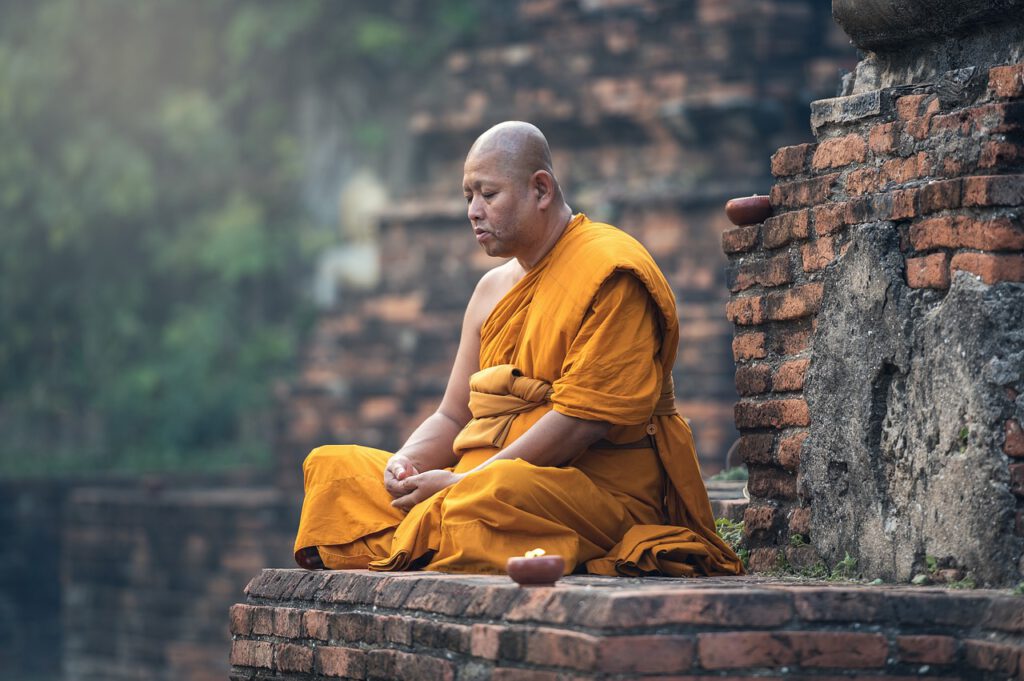
Vipassana meditation is an ancient meditation technique that has its origins in ancient India. It was developed by Siddhartha Gautama, the founder of Buddhism, and has been practiced for centuries. The word “Vipassana” comes from Pali, one of the oldest Buddhist languages, and means “clear insight” or “true perception”. Vipassana meditation aims to calm the mind by consciously focusing on present experience. S.N. Goenka then made this meditation accessible to a large number of students using the Vipassana technique.
Instructions for Vipassana meditation
- Find a quiet place where you are undisturbed. Sit down comfortably and close your eyes. Either sit on a chair or, if you are sitting on the floor, make sure your knees are supported. In Vipassana, we anchor ourselves with the body and the breath and thus ensure a deep calming of our nervous system. We should therefore adjust our surroundings accordingly.
- Breathe in and out deeply to calm your mind. Notice how your belly rises and falls as you breathe in and out. This breath observation serves as an anchor point to focus your attention. We start at the point below the belly button to maintain our concentration and create an anchor. At the same time, this point brings us further into deep relaxation.
- As you observe your breath, you will notice that many thoughts and sensations arise in your mind. This is completely normal. Just let these thoughts and sensations come and go without holding on to them or letting them distract you. Look at them like clouds passing by. Gently bring your attention back to observing your breath again and again.
- Another important aspect of Vipassana meditation is body awareness. Focus your attention on the sensations in your body. Feel the contact of your body with the floor, the position of your limbs and any tension or relaxation. Notice how different parts of your body feel without making a judgment or interpretation. Simply observe the physical sensations.
- Be patient with yourself and allow yourself to learn this process step by step. Vipassana meditation requires regular practice in order to develop its full effect. Through prolonged sitting, the physical and mental experiences can quickly become intense, especially due to the simplicity of the practice. Breath and body are subject to constant change and we may feel lost during meditation.
- The important principle is to focus on the sensation that is arising. It may be a negative emotion or a physical reaction. We go into complete acceptance and experience everything in the moment. We should accept our limits and not try to “endure” the meditation.
Passive observation of internal movements
The conscious observation of thoughts and emotions is the core of Vipassana meditation. When thoughts or emotions arise, observe them without judgment or evaluation. Observe how they come and go, how they change and dissolve. Recognize that thoughts and emotions are temporary and that you are not identified with them. This conscious observation allows you to reach a deeper level of understanding and serenity.
Vipassana and everyday life
It is important to emphasize that Vipassana meditation requires time and patience. It is not a quick fix for all of life’s problems, but a continuous practice that invites you to get to know yourself better and establish a deeper connection with your inner being. The more regularly you practice, the more you will feel the positive effects of Vipassana meditation in your life.
In today’s fast-paced world, Vipassana meditation can be a valuable way to bring calm and clarity to your everyday life. It can help you to reduce stress, improve your concentration and increase your general well-being. By training your mind, you can develop a deeper inner wisdom and serenity that will help you deal with life’s challenges. Vipassana meditation is taught in free 10-day courses. Contacts can be found on the Vipassana Meditation website.